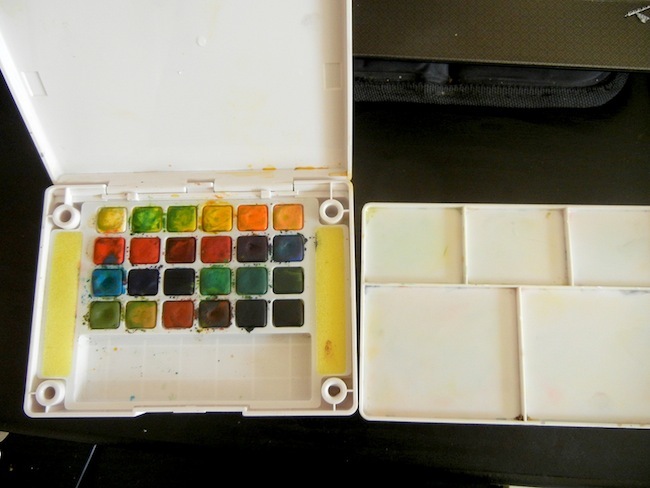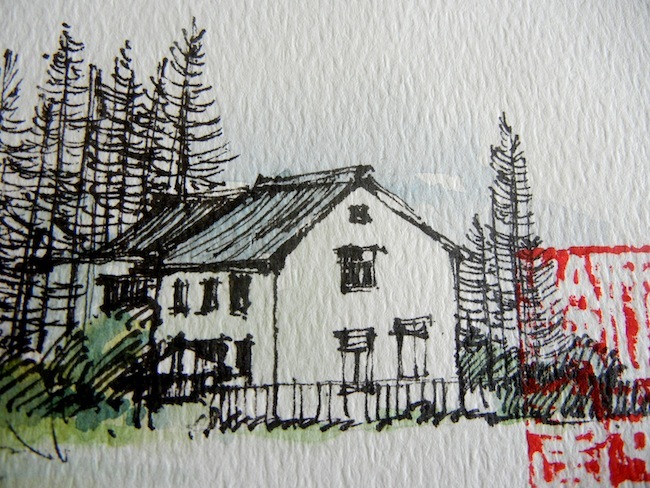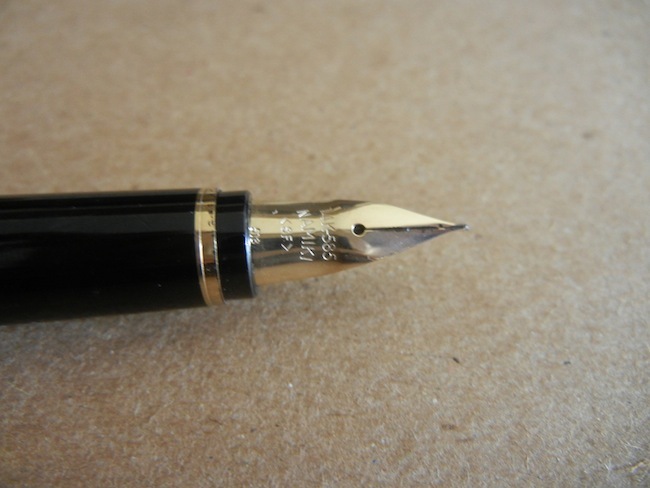As a follow up to commonly asked questions about the drawing equipment I use in my landscape sketches, I’ve rounded up a list of some of my commonly used tools. These days, many art supplies are quite expensive. Luckily, however, I don’t use many expensive tools. For beginners, I strongly suggest starting with simple tools because they are easy to use and more affordable. In addition, starting out with the bare bone tools makes it easier to see how line quality can then be improved with higher quality equipment.
RELATED STORY: Interview with Urban Sketcher Chunling Wu
I usually use color pencils/watercolor color pencils for design rendering and watercolor for urban sketching. I encourage you to try different media and mixed media because doing so can help you find your personal preferences and unique style.
I use Platinum carbon ink (bottle ink black 60cc) imported from Japan. I prefer waterproof ink such as this one because I like to add watercolor after using the ink to create a black outline. As a high quality product, this carbon ink is consistently black and never clogs up. Impermanent ink such as this is also good for times when you want to add ink at the end of the drawing process. For instance, I sometimes to choose to spread the ink out overtop a sketchy watercolor drawing to create shading or other special effects.
In most sketches, I use the Hero 1077 bent nib fountain pen (1077 also has straight nib model). This is a great pen with a good price (less than 10 dollars); you may want to change the converter, though. A bent nib allows me produce rich dynamic lines and allows me to create different textures and special effects by holding the pen in different angles and controlling the pressure. The other pen I often use is the Namiki fountain pen. Its nib was modified a little bit for more flexibility; however, it may not be the best choice for people who like to press down hard on pens. If you have that tendency, the Lamy Safari fountain pen is a better consideration.
I use the Uni Pin Pigment waterproof pens for design and urban sketching (0.3 and 0.5). I like to use these pens to create a clean and crisp style. Other brands listed include: the Faber-Castell Pitt artist pen (B), a brush-like pen that can be used to color large black areas such as people’s hair, clothes or windows; the Staedtler Permanent Lumocolor (F) and Sharpie permanent Marker (Ultrafine point), which are also good choices for most sketches since they produce nice spread-out effects on certain kinds of sketch paper; and General Black gel pens or ball pens, which I use a lot for drawing. In the first year of master’s study, I bought a box of gel pens for most of my communications assignments.
RELATED ALBUM: Chunling Wu’s MLA Portfolio
INK PEN CLEANING
KOH-I-NOOR Rapido-Eze Clearning Solution. This is a great product for cleaning your fountain pen in case you bought wrong ink that’s clogged your pen.
WATERCOLOR BRUSHES
 For most of my sketches, I use the Yasutomo Niji Water Brush. The reason I like this brand is because the brush material is more elastic and not too soft. I’ll use Chinese brushes made from weasel’s hair for the background wash. Personally, I prefer round animal hair brushes because animal hair can absorb water easily. Synthetic hair is also a good choice for students who cannot afford expensive animal hair brushes. I recently bought large round and flat brushes (synthetic versions of squirrel, 10 and 12 size) from Princeton Neptune. I also use Nylon brushes, however, I wouldn’t recommend flat watercolor Nylon brushes for beginners. To properly choose the types of brushes that best fit your drawing style however, you need to try them yourself. The type of brush you’ll use also depends on how you color your drawings.
For most of my sketches, I use the Yasutomo Niji Water Brush. The reason I like this brand is because the brush material is more elastic and not too soft. I’ll use Chinese brushes made from weasel’s hair for the background wash. Personally, I prefer round animal hair brushes because animal hair can absorb water easily. Synthetic hair is also a good choice for students who cannot afford expensive animal hair brushes. I recently bought large round and flat brushes (synthetic versions of squirrel, 10 and 12 size) from Princeton Neptune. I also use Nylon brushes, however, I wouldn’t recommend flat watercolor Nylon brushes for beginners. To properly choose the types of brushes that best fit your drawing style however, you need to try them yourself. The type of brush you’ll use also depends on how you color your drawings.
WATERCOLOR



 sI have two sets of watercolors. The first is the Koi Water Color Pocket Field Sketch Box. Generally these colors are enough for sketching and a really great choice for beginners. My favorite watercolor sets, however, are Daniel Smith. I also have different empty pans that I can fill from watercolor tubes so I can create a palette of my favorite colors. The color palette I’ve shown above is from James Richards’ book Freehand Drawing & Discovery P146: Raw Sienna, Burnt Sienna, Cadmium Red, Alizarin Crimson, Cadmium Yellow, Prussian Blue, French Ultramarine, Cerulean Blue, Hooker’s Green, Raw Umber and Payne’s Gray. Naples Yellow is a great one for buildings and stonework; Richards has since added that color to this list.
sI have two sets of watercolors. The first is the Koi Water Color Pocket Field Sketch Box. Generally these colors are enough for sketching and a really great choice for beginners. My favorite watercolor sets, however, are Daniel Smith. I also have different empty pans that I can fill from watercolor tubes so I can create a palette of my favorite colors. The color palette I’ve shown above is from James Richards’ book Freehand Drawing & Discovery P146: Raw Sienna, Burnt Sienna, Cadmium Red, Alizarin Crimson, Cadmium Yellow, Prussian Blue, French Ultramarine, Cerulean Blue, Hooker’s Green, Raw Umber and Payne’s Gray. Naples Yellow is a great one for buildings and stonework; Richards has since added that color to this list.
COLORED PENCILS
 I primarily use Prismacolor Colored Pencils. I’ll usually mix them with my other watercolor pencils (below). The color palette above is from James Richards’ book Freehand Drawing & Discovery P29: Light Peach, Cream, Lavender, Aquamarine, True Blue, White, Grass Green, Dark Green, Yellow Ochre, Apple Green, Spring Green, Oliver Green, Warm Gray 70%, Burnt Ochre, Terre Cotta, Carmine Red and Black.
I primarily use Prismacolor Colored Pencils. I’ll usually mix them with my other watercolor pencils (below). The color palette above is from James Richards’ book Freehand Drawing & Discovery P29: Light Peach, Cream, Lavender, Aquamarine, True Blue, White, Grass Green, Dark Green, Yellow Ochre, Apple Green, Spring Green, Oliver Green, Warm Gray 70%, Burnt Ochre, Terre Cotta, Carmine Red and Black.
WATERCOLOR PENCILS
 Just like with my watercolor palettes, I use two different brands of watercolor pencils. After experimenting with different brands, I’ve decided that Swiss-made Caran D’ache is my favorite. I like to use them as regular color pencils in design renderings. Their wax content is low enough that I can overlap the colors. They give a nice watercolor-like tone and create nice strokes.
Just like with my watercolor palettes, I use two different brands of watercolor pencils. After experimenting with different brands, I’ve decided that Swiss-made Caran D’ache is my favorite. I like to use them as regular color pencils in design renderings. Their wax content is low enough that I can overlap the colors. They give a nice watercolor-like tone and create nice strokes.
SKETCHBOOK AND PAPER
 I usually use the Moleskine Art Plus Watercolor Album, A4, Black, Hard Cover (12 x 8.5) (Professional Folio Series). This sketchbook allows me to do a little bit of a watercolor wash and provides enough room for a customized design.
I usually use the Moleskine Art Plus Watercolor Album, A4, Black, Hard Cover (12 x 8.5) (Professional Folio Series). This sketchbook allows me to do a little bit of a watercolor wash and provides enough room for a customized design.

 I don’t have a preference on a brand of watercolor paper. I usually choose watercolor paper based on its thickness and paper texture. Currently, I’m using Strathmore Windpower Watercolor cold press and acid free watercolor paper. It’s 9”X12” with 140lb. This type of paper has a light texture and it’s pretty smooth for pen and watercolor. For a rougher version, you can try the Bee Paper Aquabee, 11”X15” with 140lb. Although it is not easy to show details on “bumpy” paper, drawing on rougher paper creates a great loose feeling to your art.
I don’t have a preference on a brand of watercolor paper. I usually choose watercolor paper based on its thickness and paper texture. Currently, I’m using Strathmore Windpower Watercolor cold press and acid free watercolor paper. It’s 9”X12” with 140lb. This type of paper has a light texture and it’s pretty smooth for pen and watercolor. For a rougher version, you can try the Bee Paper Aquabee, 11”X15” with 140lb. Although it is not easy to show details on “bumpy” paper, drawing on rougher paper creates a great loose feeling to your art.















